The Silk Road: How Ancient Trade Routes Shaped the Modern World
The Enduring Legacy of the Silk Road: Ancient Trade Routes Connecting East and West

The Silk Road's Legacy: For centuries, the Silk Road was not merely a single road, but an intricate network of historical trade routes spanning over 4,000 miles, connecting diverse civilizations across East and West. Beyond its primary role as a conduit for valuable goods like silk, this ancient network facilitated a profound cultural exchange of ideas, religions, and technologies that significantly shaped the societies it touched. This article delves into the rich history of the Silk Road, exploring its origins, peak influence, eventual decline, and its remarkable modern revival.
The Origins and Development of the Silk Road: A Journey Through Ancient History (2nd Century BCE - 14th Century CE)

Ancient Origins: The true origins of the Silk Road can be traced to the Han Dynasty in China (207 BCE – 220 CE). Emperor Wu of Han strategically dispatched Zhang Qian as an envoy, aiming to forge alliances against the nomadic Xiongnu group that posed a threat to China's borders. While a full military alliance didn't fully materialize, Qian’s extensive travels opened up vital trade routes into Central Asia, sparking considerable interest in Western goods, especially horses, and laying the essential groundwork for the extensive Silk Road.
Trade Dynamics: Initially, trade along these routes was largely conducted by nomadic groups acting as crucial intermediaries. However, over time, established and well-traveled routes emerged, passing through vibrant oasis cities such as Samarkand, Bukhara, and Kashgar. These cities flourished as dynamic centers of commerce and cultural exchange, offering indispensable services to both merchants and travelers. The substantial demand from the Roman Empire for exquisite silk, exotic spices, and other Eastern luxuries significantly fueled the westward expansion of this vital trade route, while China sought valuable commodities like horses, wool, linen, and precious metals from the West.
Beyond Goods: The Profound Cultural Exchange and Spread of Ideas on the Silk Road

Spread of Religions: The influence of the Silk Road extended far beyond the mere exchange of material goods; it served as a pivotal vector for the global spread of religions and philosophies. Buddhism, for instance, originating in India, traveled eastward along these trade routes, becoming deeply ingrained in Chinese, Korean, and Japanese cultures. Other significant faiths like Nestorian Christianity, Manichaeism, and Islam also found new adherents and established communities along these vital pathways.
Technological Transmission: Furthermore, the Silk Road was instrumental in the transmission of groundbreaking technological innovations. Chinese papermaking techniques, the formidable invention of gunpowder, and the indispensable compass gradually made their way westward, fundamentally revolutionizing European society. Conversely, Western advancements in fields such as astronomy, mathematics, and medicine were introduced to the East. This vibrant exchange led to the intermingling of artistic styles, musical traditions, and literary motifs, ultimately forging a rich and diverse tapestry of cultural fusion across Eurasia.
The Decline and Lasting Legacy of the Silk Road (15th Century CE - Present)

Reasons for Decline: The prominence of the Silk Road began its decline in the 15th century, influenced by several key factors. The emergence of new maritime trade routes, notably pioneered by European explorers like Vasco da Gama, offered a significantly faster and more economical alternative for transporting goods. Furthermore, escalating political instability within Central Asia, including the fragmentation of the vast Mongol Empire, severely disrupted traditional trade flows. The growing control of the Ottoman Empire over crucial land routes further hindered trans-Eurasian commerce.
Enduring Impact: Despite its historical decline, the Silk Road’s legacy remains profoundly influential. It fostered unprecedented interconnectedness between diverse civilizations, leaving an indelible mark on the cultural, economic, and political landscape of Eurasia. The spirit of the ancient Silk Road continues to inspire modern initiatives, most notably China’s expansive Belt and Road Initiative (BRI), a massive infrastructure project aimed at reviving trade and enhancing connectivity across Asia, Africa, and Europe.
The Modern Silk Road: Understanding China's Belt and Road Initiative

The Belt and Road Initiative: Launched in 2013, the Belt and Road Initiative (BRI) represents China's ambitious effort to construct a vast network of railways, roads, ports, and other critical infrastructure projects, connecting China with over 150 countries worldwide. While the BRI has garnered praise for its potential to significantly boost global economic development and foster regional cooperation, it has also faced scrutiny regarding issues such as debt sustainability for participating nations, environmental concerns, and broader geopolitical implications. Nevertheless, it undeniably signifies a deliberate and massive effort to rekindle the vibrant spirit of the ancient Silk Road, albeit on a vastly expanded and modernized scale, aiming to redefine Eurasian trade and connectivity.
Conclusion

Final Thoughts: The Silk Road stands as an enduring testament to the transformative power of international trade and profound cultural exchange. Its immense impact reverberates throughout history, fundamentally shaping the interconnected world we inhabit today. From the widespread dissemination of religions like Buddhism and pivotal technologies, to the flourishing of ancient oasis cities and the ambitious modern-day Belt and Road Initiative, the Silk Road's legacy continues to bridge East and West, serving as a powerful reminder of the deep and continuous interconnectedness of human civilization and global Eurasian trade.
```